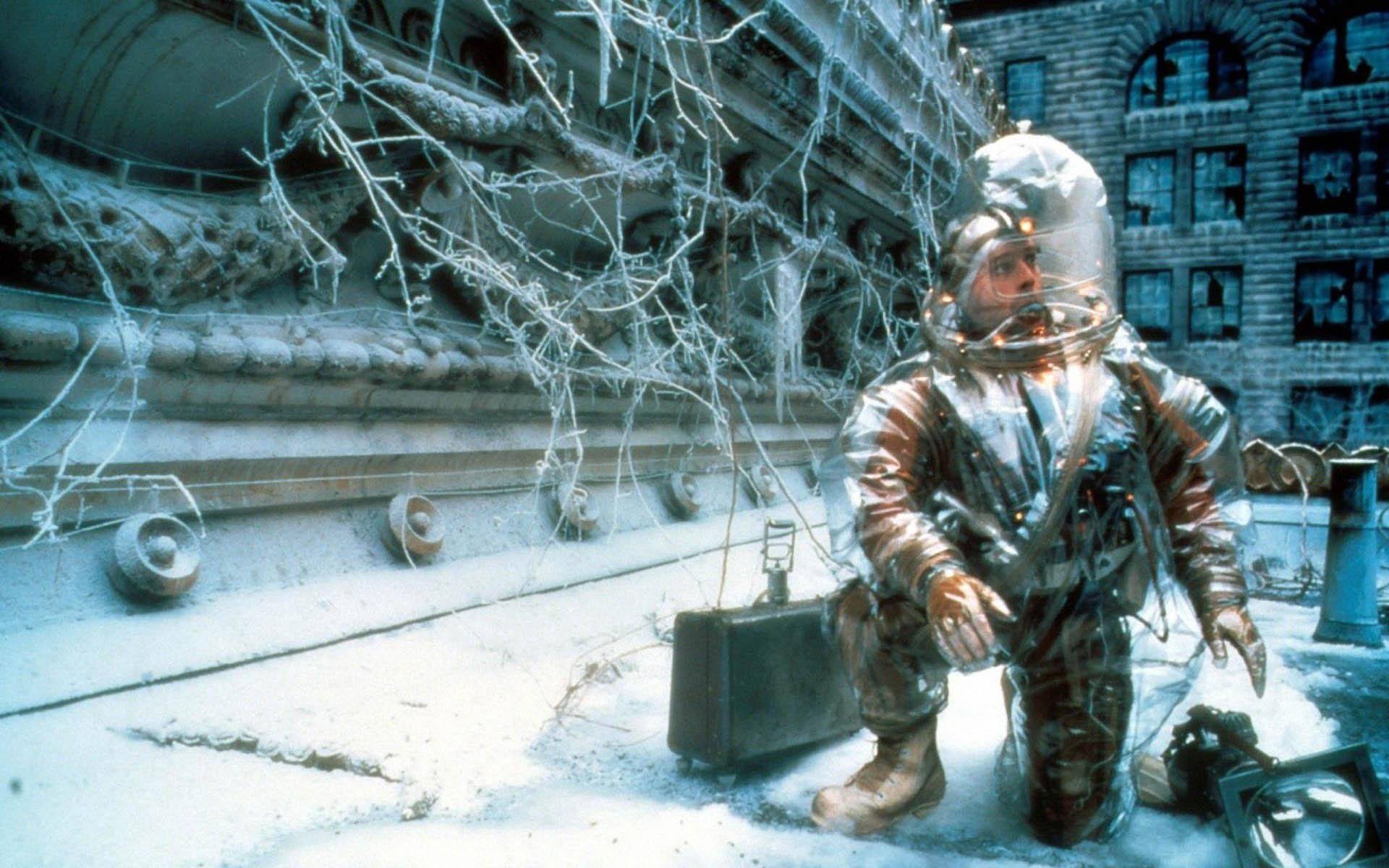12 Monkeys (1995)

Released in 1995, 12 Monkeys is an American science fiction thriller directed by Terry Gilliam. The film, based on a screenplay by David and Janet Peoples, draws inspiration from the 1962 French short film La Jetée by Chris Marker. Featuring an ensemble cast including Bruce Willis, Madeleine Stowe, Brad Pitt, and Christopher Plummer, 12 Monkeys combines dystopian themes, intricate narrative structure, and psychological depth to create a compelling cinematic experience.
12 Monkeys is set in a dystopian future where humanity has been decimated by a devastating viral outbreak. The film begins in the year 2035, with the remnants of the human population living underground, having retreated from the surface due to the virus that has rendered the world’s surface uninhabitable. The protagonist, James Cole (Bruce Willis), is a convicted criminal who is offered a chance for freedom in exchange for participating in a risky mission: to travel back in time to gather information about the origins of the virus and possibly prevent its release.
Cole’s time-travel journey takes him to the year 1996, just before the outbreak of the virus. His mission leads him to investigate the activities of a mysterious group known as the Army of the 12 Monkeys, who are believed to be responsible for the viral epidemic. As Cole navigates this unfamiliar past, he encounters Dr. Kathryn Railly (Madeleine Stowe), a psychiatrist who becomes entangled in his mission, and Jeffrey Goines (Brad Pitt), an eccentric and unhinged activist associated with the 12 Monkeys group.
As Cole struggles to piece together the fragments of his mission, he becomes increasingly disoriented and uncertain of what is real. The film delves into themes of insanity, reality, and the nature of time as Cole’s journey reveals disturbing truths about the virus, the 12 Monkeys, and his own place in the unfolding events. The narrative twists and turns, challenging the viewer’s perceptions and culminating in a climax that questions the very nature of time and causality.
Terry Gilliam’s direction in 12 Monkeys is marked by his signature visual style, which combines surrealism with gritty realism. Gilliam’s approach to the film emphasizes the disorientation and psychological tension experienced by the protagonist. His use of distinctive visual motifs, such as distorted camera angles and unconventional framing, reflects the film’s themes of fractured reality and time distortion.
The cinematography, managed by Roger Pratt, complements Gilliam’s vision with a visual style that captures both the bleakness of the dystopian future and the chaotic atmosphere of the past. The film’s color palette shifts between the drab, industrial tones of the future and the more vibrant, yet unsettling, hues of the 1990s. This contrast enhances the sense of temporal dislocation and amplifies the film’s eerie and unsettling atmosphere.
12 Monkeys explores several profound themes, including the nature of time, the concept of sanity, and the impact of human actions on the future. The film’s narrative structure and thematic content encourage viewers to question their understanding of reality and the consequences of their choices.
The nature of time is a central theme in 12 Monkeys. The film examines the concept of time travel and its implications for causality and destiny. Through Cole’s experiences, the film poses questions about whether the future is predetermined or if it can be altered by actions taken in the past. The cyclical nature of time is a recurring motif, as the film explores how past, present, and future are interconnected and influence one another.
Sanity and the perception of reality are also key themes in the film. Cole’s journey is marked by confusion and uncertainty, as he struggles to distinguish between his own perceptions and the objective reality of the world around him. The film delves into the psychological effects of time travel and the impact of trauma on mental health, creating a complex and layered portrayal of sanity and delusion.
The impact of human actions on the future is a significant theme explored through the film’s plot. The film raises questions about responsibility and the consequences of individual and collective actions. The Army of the 12 Monkeys, as a symbol of radical activism and societal upheaval, represents the potential for human actions to have far-reaching and often unintended consequences.

The performances in 12 Monkeys are a highlight of the film, with each actor bringing depth and complexity to their roles. Bruce Willis delivers a compelling portrayal of James Cole, capturing the character’s vulnerability and determination. Willis’s performance conveys both the physical and emotional challenges faced by Cole, adding depth to the character’s journey.
Madeleine Stowe’s portrayal of Dr. Kathryn Railly provides a grounded counterpoint to Cole’s disorientation. Stowe’s performance adds a layer of emotional depth and moral complexity to the film, as her character grapples with her own doubts and the ethical implications of Cole’s mission.
Brad Pitt’s performance as Jeffrey Goines is one of the film’s standout elements. Pitt brings a frenetic energy and intensity to the role, creating a memorable and eccentric character that adds a layer of unpredictability to the film. His portrayal of Goines captures the character’s instability and charisma, making him a compelling and enigmatic figure within the narrative.
Christopher Plummer’s role as Dr. Peters adds an additional layer of intrigue and complexity to the film. Plummer’s performance enhances the film’s exploration of themes related to authority and manipulation, contributing to the overall sense of suspense and mystery.

12 Monkeys received generally positive reviews from critics, who praised its imaginative storytelling, complex narrative, and strong performances. The film was recognized for its originality and its ability to blend science fiction with psychological and philosophical themes. While some critics found the film’s narrative challenging and convoluted, many appreciated its thought-provoking content and its exploration of time travel and reality.
The film has since gained a cult following and is considered a notable entry in the science fiction genre. Its influence can be seen in subsequent films and television shows that explore similar themes of time travel and reality. 12 Monkeys remains a significant example of Terry Gilliam’s unique directorial vision and his ability to create compelling and unconventional cinematic experiences.

12 Monkeys (1995) is a mind-bending science fiction thriller that combines Terry Gilliam’s distinctive directorial style with a complex and thought-provoking narrative. Featuring strong performances from Bruce Willis, Madeleine Stowe, Brad Pitt, and Christopher Plummer, the film explores themes of time, sanity, and the impact of human actions on the future. Through its innovative storytelling, striking visuals, and exploration of profound concepts, 12 Monkeys stands as a significant and enduring entry in the science fiction genre, offering a compelling and immersive cinematic experience that continues to resonate with audiences.










